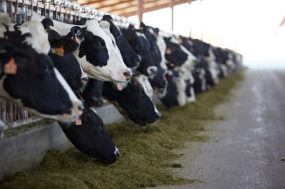In addition, they aimed at developing a new measure of FE based on the NRC net energy model.
To this effect, the researchers collected daily records of nutrient intake, fat- and protein-corrected milk yield (FPCM), bodyweight (BW) and body condition score (BCS) to model seven different indices of feed efficiency (gross feed efficiency [GFE]), return over feed costs (ROFC), residual feed intake (RFI), residual net energy intake (REI) and net energy efficiencies of lactation (NEEL), maintenance (NEEM) and body reserves (NEEF).
Forty primiparous Holstein heifers, from zero to 150 days in milk (DIM), were used in the study, which took place at the Livestock Research and Innovation Centre – Dairy in Wellington. Research on feed efficiency measures relate to the importance of feed costs on dairy operations. The authors indicate this has triggered research into breeding animals that use feed more efficiently, thereby reducing feed costs per unit of product, such as milk.
Other than the traditional FE measures, the authors calculated new FE measures: net energy efficiency of lactation, net energy efficiency of maintenance and net energy efficiency flux. The authors explain that these novel measures of feed efficiency represent the proportion of net energy available that is estimated to move through each respective flux and provide measures more representative of the underlying biological processes relating to energy and FE. The study concluded that feed efficiency is very dynamic and fluctuated over the course of the experimental period, regardless of the efficiency measure used.
The period of time of studies about FE is critical since, for example, the non-linear nature of the lactation curve has a strong impact on daily variations on efficiency. This means the “true” efficiency of an animal is unlikely to be estimated from a small number of measurements due to day-to-day variability.
Of the measures evaluated, return over feed costs would be most suited for management purposes due to practicality and simplicity, whereas other measures such as the efficiency of net energy flux to and from body reserves, present potential targets for inclusion in breeding goals. This is important because it may reduce the time required to estimate whole-lactation efficiency.
“Invited review: Compost-bedded pack barns for dairy cows.” Journal of Dairy Science Vol. 103 No. 2, 2020. This article reviews current scientific knowledge about compost-bedded packs (CBP) with the aim of providing a comprehensive tool for producers and researchers using this housing system.
The authors explain that CBP barns are a relatively new loose housing system for dairy cows that appear to increase cow comfort. Similarly to straw yards (SY), in CBP, cows are provided with an open bedded pack area for resting and exercise rather than the individual stalls and concrete alleys in freestall (FS) systems. However, in CBP, unlike conventional SY, the entire pack is cultivated one to three times per day, and the area per cow required is generally higher than that in other housing systems.
The authors refer that although cow excreta is mixed into the bedding, thus potentially increasing the risk of poor cow hygiene, properly managed CBP can provide a health-promoting, dry and comfortable surface on which cows can lie, stand and walk. Because the animals can walk freely within the barn, the term “freewalk housing” has been used to describe this system.
Different countries implemented this housing system and, although they all share similar characteristics, there are differences between the systems, and the authors say that an open bedded area and frequent pack cultivation appear to be the only feature the different CBP systems have in common. Currently, there are two main systems used. The one that is more prevalent in the U.S. focuses on heat production in the pack. In this type of CBP, the area per cow is smaller (around 9.3 square metres per cow but variable within states) than that in other CBP systems, and the most important issue is maintaining adequate chemical and physical characteristics of the substrate to promote microbial activity, which produces heat and in turn supports pack drying.
Another type was developed in Israel. Here, due to the nature of the climate, CBP are based on the concept of providing cows with large spaces (around 15 square metres per cow). Owing to the warm and dry climate and large area per cow, little to no bedding is needed to keep the pack dry. Although CBP in Israel are also regularly cultivated, less emphasis appears to be placed on heat development in the pack compared with CBP in the U.S.
This is a long article focusing on different aspects of this type of housing system, and it is an important read for farmers thinking about building or retrofitting their barns. The authors conclude that the main benefits of this system include improved cow comfort, better foot and leg health, more natural animal behaviour and improved manure quality. The results with CBP, however, strictly depend on pack management. Producers should pay particular attention to maintaining adequate pack moisture, which appears to be the most important factor in CBP management.
Still, some doubts remain in regards to animal welfare, namely the fact that the effects of CBP on longevity are not yet considered consistent, as well as regarding the risk of mastitis. In fact, research has demonstrated that even maintaining a high temperature to promote bedding sanitation, microbial analysis indicate most mastitis-causing bacteria can grow at the temperatures recorded in composting packs. Finally, research on the economic aspects of CBP remains sparse. ![]()
RESEARCH REVIEW
This column brings you information regarding some of the research being done around the world and published in the Journal of Dairy Science. The objective is to bring to light areas of research that may have an immediate practical application on a dairy farm as well as research that, even though it may not have a practical impact now, could be interesting for its future potential application. The idea is to give a brief overview of select research studies, but not go into detail on each topic. Those interested in further in-depth reading can use the citations to find each study.

-
Pedro Nogueira
- Nutritionist
- Shur-Gain
- Email Pedro Nogueira









